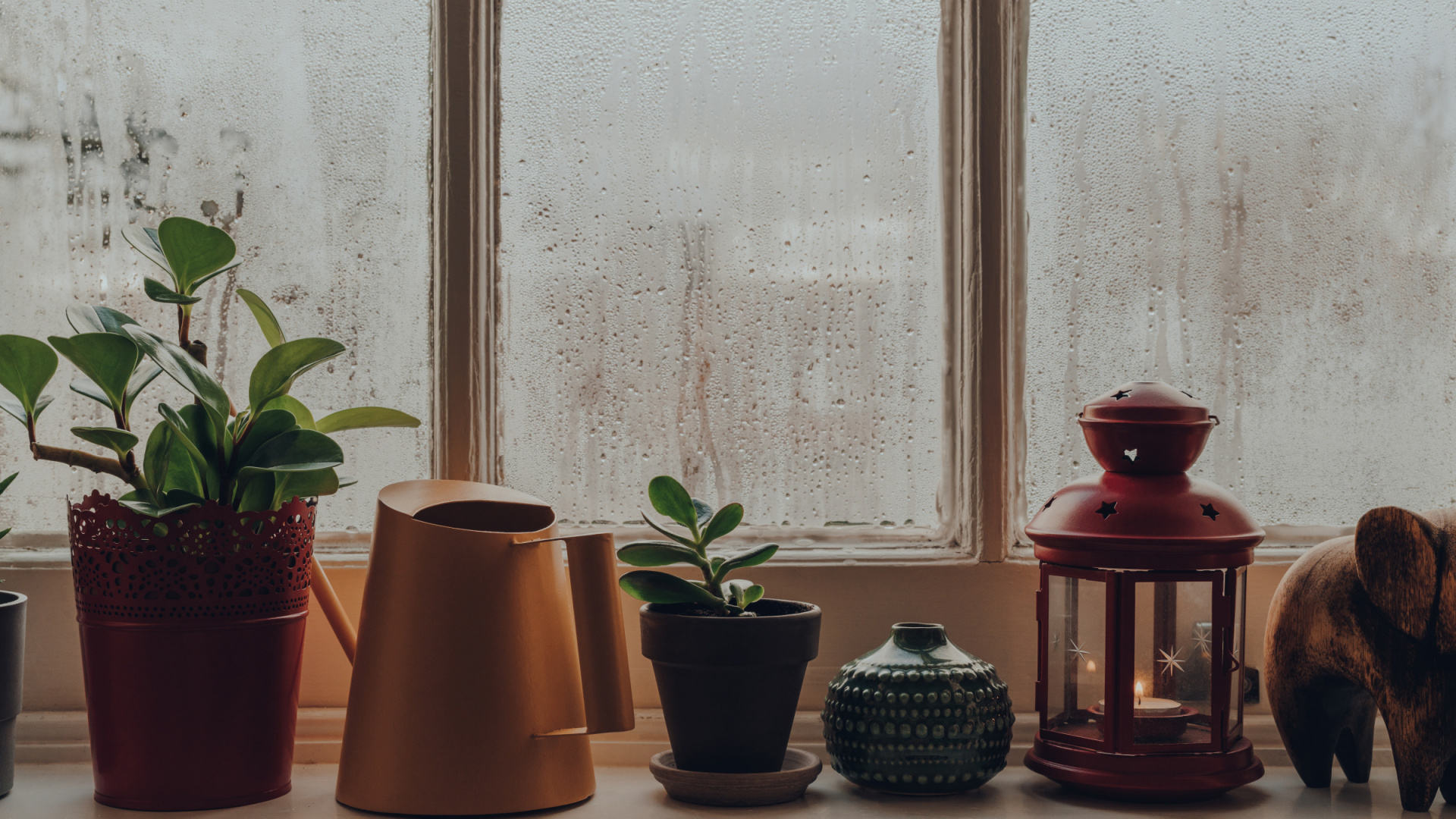CONTROLLING THE MOISTURE IN YOUR HOME
If you’ve braved a Manitoba winter, you’ve likely noticed the changes that occur in your home throughout the season. The air becomes drier when your heat is on longer and you’re probably experiencing more static electricity, yet you may see condensation forming on the windows. Why is that and how can you get it under control? Keep reading for insights and actions you can take.
CAUSES OF CONDENSATION & HUMIDITY
Everything around us contains moisture: the carpet, the floors, the walls, even the pile of newspapers on the kitchen table. The air around us contains a certain level of moisture too. When we talk about humidity, we usually mean relative humidity, which refers to the percentage of moisture in the air compared to the maximum moisture the air can hold.
Condensation appears when relatively warm and humid air comes in contact with a cold surface. This is most commonly seen on our windows during the colder months while we’re heating our homes, or in the bathroom after a shower. The temperature of the warm air drops rapidly as it contacts the cold window, releasing the moisture it contained. The same principle applies throughout your home and can occur behind your walls or in your attic. This can lead to the growth of mould or other potentially serious problems.
REDUCE CONDENSATION IN YOUR HOME
While you want to maintain some humidity in your home, you’ll want to reduce the amount of condensation that forms as a result. Here are some ways you can manage the condensation in your home:
USE YOUR HEAT RECOVERY VENTILATOR (IF YOU HAVE ONE)
A heat recovery ventilator (HRV) or energy recovery ventilator (ERV) can help control the humidity levels in your home and prevent condensation from forming. In winter, warm moist air is exhausted from the home and used to pre-heat drier, incoming fresh air from outside. Many homes in Manitoba have an HRV, but homeowners often have theirs switched off.
An HRV can be used year-round; however, using it during the summer months may increase the temperature inside your home or increase the operation of your air conditioning. Your HRV is most beneficial during the colder months, when the temperature outside is drastically different from the temperature inside your home. If you’re not sure how to use your HRV, check out this article for more information.
If you don’t have an HRV, ensure that kitchen and bathroom exhaust fans are connected and properly exhausting outdoors (rather than into an attic space). Wall switch timers are a convenient way to remove moisture from these spaces without wasting energy.
UPGRADE YOUR WINDOWS
As we mentioned before, your windows are typically where you can see condensation forming and can also play a big part in the levels of relative humidity in your home. If you live in an older home, your windows may be leaky, inefficient, and not doing much when it comes to insulation. Triple pane windows offer more of an insulating barrier, so they’ll do a better job of regulating the temperature inside your home.
If you’re looking to buy new windows, ensure that they’re ENERGY STAR® certified. You can evaluate the energy efficiency of different windows by comparing two metrics: the U-factor, where a lower value is preferred, and the energy rating (ER), where a higher value is preferred. Keep in mind that an energy-efficient window must be installed correctly to be effective. Poorly installed windows present prime opportunities for energy-wasting air leakage as well as potential damage to your walls if detailing doesn’t properly manage rain and snow.
By upgrading your windows, you can improve comfort, durability, and energy efficiency! We have multiple ways to help you save on your upgrade. If you’re not ready to upgrade your windows just yet, consider purchasing a window insulating kit. The plastic film will act like another pane of glass and can help reduce heat loss and cold air leakage into your home.
UPGRADE YOUR INSULATION & AIR SEALING
Air leakage carries air inside your walls and ceiling which can contribute to condensation. If you’ve been noticing drafts or condensation, your home may not have enough insulation or have air leakage that’s bypassing the insulation — especially if your home is older.
With proper insulation and air sealing to reduce heat loss and air leakage, you can decrease the presence of cold surfaces and condensation within your home, plus make your home more comfortable and save energy. We offer a variety of ways to help make your insulation upgrade more affordable.
YOU’VE MADE UPGRADES — WHY DO YOU STILL HAVE CONDENSATION?
Even if you’ve upgraded your windows, doors, and insulation, you may still notice condensation and higher levels of humidity in your home. This is because the upgrades have made the building envelope of your home more airtight, reducing drafts and leaks from entering your home. While this improves the energy efficiency and comfort of your home, it also means that there’s less air exchange with the outdoors — any moisture that’s created inside your home, such as from cooking or showering, can accumulate more easily.
If you have an HRV, you may need to adjust its relative humidity (RH) settings to account for the moisture and condensation. Some HRVs have a dehumidistat to automatically run on a higher setting when indoor humidity is high. Depending on the outdoor air temperature and specifics of your home, 20 to 50% relative humidity is typically appropriate. If you don’t have an HRV, running bathroom and kitchen exhaust fans can remove moisture, while running your furnace fan continuously can also to keep air circulating in your home.
HANDY TIPS TO COMBAT CONDENSATION
Here are a few more tips to keep the condensation in your home at bay:
- Run a dehumidifier:
A dehumidifier is a great option if you’re struggling with excessive moisture in your home. Most will fill a tank that can be emptied manually, while some support continuous operation and can be plumbed to a drain, requiring less effort on your part.
- Turn on the ceiling fan:
Your ceiling fans help to circulate air throughout your home and push the warm air that rises back down.
- Clear your clothes dryer exhaust:
Ensure your clothes dryer exhaust is free of any blockages or restrictions so that moisture from clothes drying doesn’t stay in your home. If you’re replacing your clothes dryer, consider a condensing unit — it removes the need to exhaust entirely.
Condensation is more prevalent during our winter cold snaps. With these tips and tools, you can keep it under control and make your home more comfortable.


